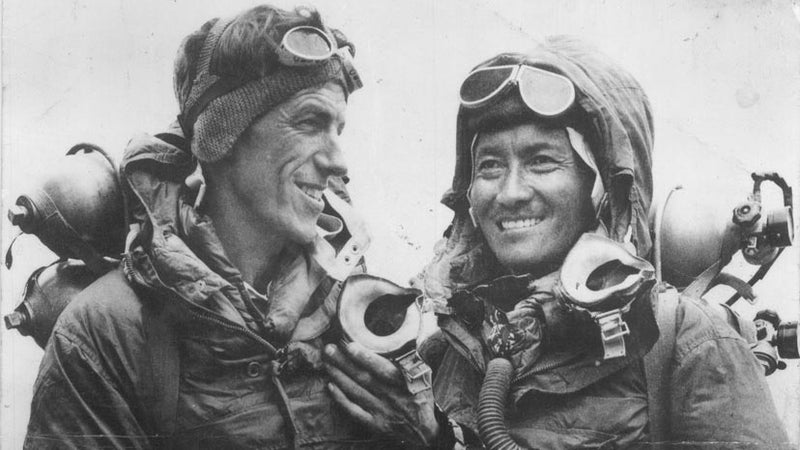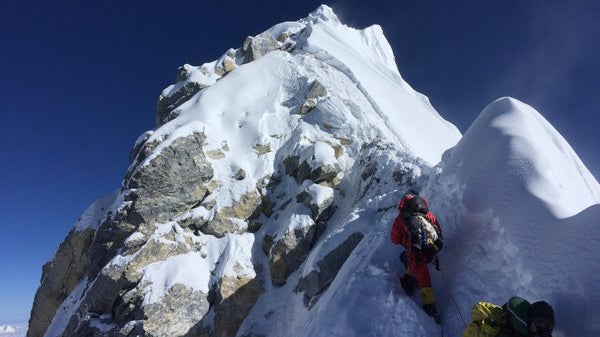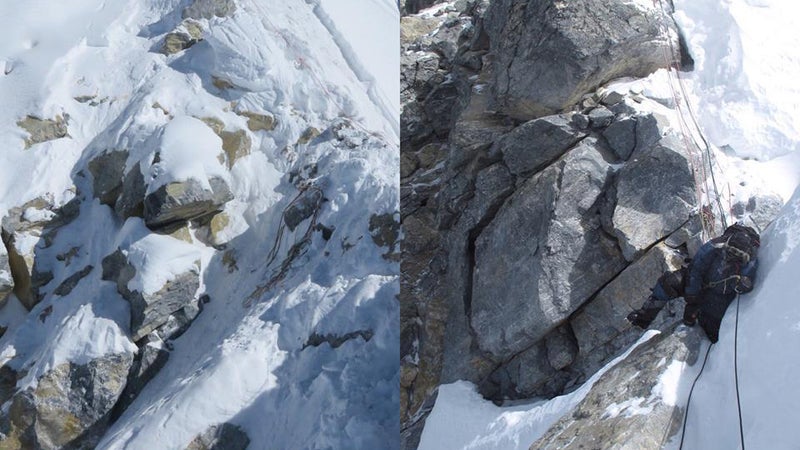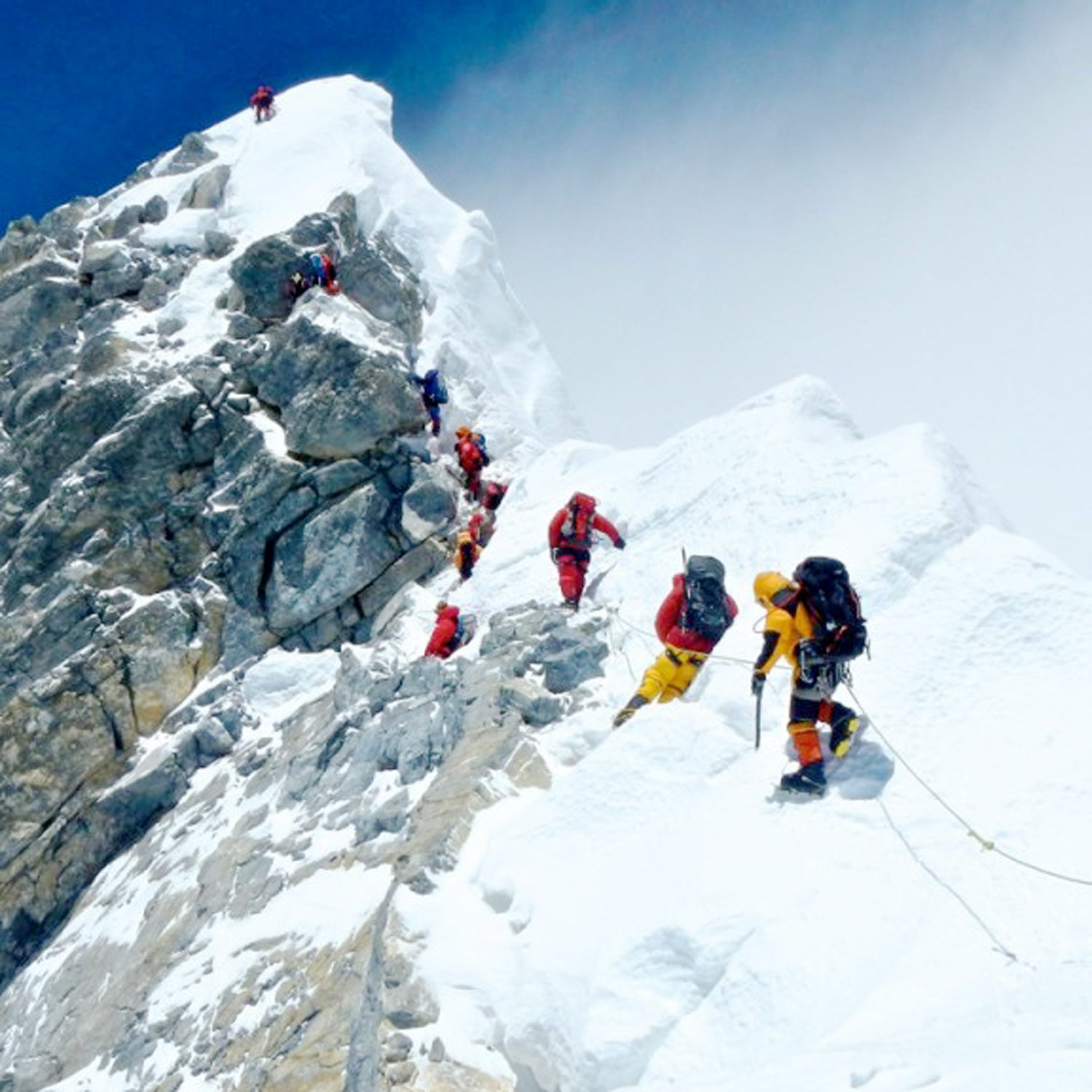The by a massive earthquake in 2015.
No, wait. The —it’s just buried beneath deep snow. Maybe.
Such has been the debate this week within the mountaineering community surrounding one of the most notorious climbing features en route to Everest’s summit.
At an elevation of 28,839 feet, the iconic Hillary Step—a near-vertical 39-foot tall rock outcropping 200 feet below the summit—is one of the last and most formidable challenges climbers must ascend before reaching the world’s highest peak via the South Col route from Nepal. Named after Sir Edmund Hillary, who used the steep feature to make the with Tenzing Norgay, the Hillary Step has become a key but treacherous challenge, where alpinists risk falling 8,000 feet to the west and 10,000 feet to the east. Traffic up the route often bottlenecks at the step: when a weather window opens the possibility of summiting, groups of climbers all set out for the top at once.
It's official – The Hillary Step is no more. Not sure what's going to happen when the snow ridge doesn't form beca…
— Tim Mosedale (@timmosedale)
But recent tectonic activity in Nepal has cast doubt as to whether the step has shifted, collapsed, or disappeared altogether—or none of the above. Just last week, British mountaineer Tim Mosedale, who summited Everest on May 16 via the South Col, confirmed that the Step is gone. Nepalese officials and Sherpas, however, dispute Mosedale’s claim, dismissing it as a “false rumor,” . Nepalese climbers claim the Step is still intact, it just can’t be seen because it’s buried beneath snow.
The mystery may not be solved until snow levels recede. But if the step is gone, one of the most traditional routes to Everest’s summit will be permanently altered. With its fate still unknown, we took a brief look at the Hillary Step’s history.
May 29, 1953: Sixty-four years ago, Sir Edmund Hillary and Sherpa Tenzing Norgay . But before the climbers could stand atop the world, they had to navigate a daunting rocky spur. According to reports, the two climbers wedged themselves between rocks on the step and an adjacent ice ridge, ax-picking and levering their way to the top. About two hours after encountering the obstacle, Hillary and Norgay reached Everest’s summit at 11:30 a.m. The rock feature was later named in Hillary’s honor.

May 1, 1963: Ten years after Sir Edmund Hillary summited Everest, . After reaching the south summit by late-morning, Whittaker and Sherpa Nawang Gombu encountered the step. Whittaker led the climb up the Hillary Step and then belayed Gombu behind him. After reaching the top of the step, and only 50 feet from the summit, Whittaker ran out of bottled oxygen. However, the pair descended safely, grabbing oxygen bottles they stashed on their way to the summit.
September 24, 1975: Dougal Haston and Doug Scott became the first British climbers to reach the summit of Everest, and their team did so by climbing the southwest face—. Because it was post-monsoon season, after ascending the southwest face, the two climbers encountered the Hillary Step buried beneath snow. The mountaineers used ropes to climb the step, which led to of Haston making his way up the Hillary Step.
May 10, 1996: Perhaps no season on Everest has been more closely examined than the one that inspired Jon Krakauer’s . One of the deadliest days on Everest began when expeditions arrived at the Hilary Step on the morning of May 10, 1996, and discovered that there were no fixed lines. The guides hurried to put them in place as clients waited, delaying their bid by an hour and pushing summit times well past the 2 p.m. turnaround time. The blizzard that quickly descended caught the remaining climbers by surprise and killed eight.
May 1997: South African climber Bruce Herrod’s body was found hanging from ropes at the bottom of the Hillary Step. Herrod became separated from his climbing party before summiting Everest in 1996, and he tried to make a night descent on his own. The late Russian climber Anatoli Boukreev recovered his body a year later.As the Hillary Step became a popular route on Everest, ropes were set in place each season to make ascents safer. However, the Step remained a treacherous and dangerous feature.
Spring 2013: Nepalese officials on the Hillary Step to ease congestion and make Everest’s summit more attainable. But the idea was controversial, prompting outcry from mountaineers who argued a ladder would cheapen the experience and not alleviate congestion.
April 25, 2015: , devastating communities around Kathmandu and the Khumbu Valley, killing thousands of people, and bringing with it several aftershocks that altered the country’s landscape. The quake, which set off a series of avalanches near Everest, killed 18 climbers, left Base Camp in ruins, and ended the 2015 climbing season on the world’s tallest mountain. It remains to be seen whether the earthquake also caused the Hillary Step to shift or crumble.
May 2016: Climbers returned to Everest in the spring of 2016 for the first time since the quake that shut down climbing on the mountain the year before. In May, , reported in his blog after summiting Everest that the Hillary Step had been . But heavy snowfall rendered the feature all but unrecognizable. Most climbers that year ascended via snowpack to the right of the Hillary Step rather than up the Step itself.

May 17, 2017: A day after summiting Everest for the sixth time, Tim Mosedale posted a photo of the Hillary Step to his Facebook and Twitter accounts, with a His photo shows two climbers ascending on deep snow pack to the right of where the Hillary Step should be. Two days later, , wrote that the Hillary Step .

May 22, 2017: On Monday, May 22, news reports emerged that authorities in Nepal deny Mosedale’s claim. , Ang Tshering Sherpa, president of the , called Mosedale’s claim “a false rumor.” Tshering said Sherpas and other officials at Everest Base Camp confirmed the Hillary Step was still intact, just covered by “excessive snowfall,” which led climbers like Mosedale to think it had collapsed.
Snowfall the past two seasons has formed a snow ridge where the Hillary Step should be, which has allowed climbers to to ascend. But if the feature is gone when snow recedes, it may be a problem. The route could become even more treacherous, complicating what is already a risky climb. As Tim Mosedale mentioned in his : “Not sure what's going to happen when the snow ridge doesn't form because there's some huge blocks randomly perched hither and thither which will be quite tricky to negotiate.”


